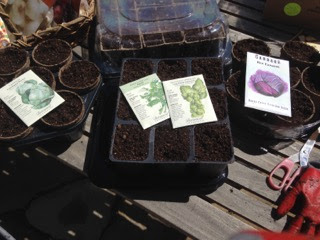by Ellyn Myller
The snow has gone from around the house, there’s been one decently warm weekend to putter in the yard, and a bed suffering from snow compaction has been readied for seeds that won’t be planted until the first week in June. Even then the frost covers will be ready to throw on if the temperatures look to dip below freezing. Our growing season is short in the valley so how do we get things to grow that take more days or growing degree units in which to mature?
This can be accomplished by using season extension methods such as starting seeds indoors, green house growing, or lighted hoop houses over raised garden beds. This year I am experimenting with starting seeds indoors. It is recommended that you begin seeds inside 6-8 weeks before the last average frost, which is June 15 in Steamboat, right about end of April beginning of May. I’m starting cabbage, butternut and acorn squash, broccoli, Brussels sprouts, and tomatoes. I’ve started some peas too, although I’ve had good success directly sowing them and may do so to observe and compare results.
There are a variety of seed starting supplies available in the stores as well as seed starting potting mix, which is recommended. The method I used was to dampen the potting mix in a large tub before putting it fairly densely into a variety of small 2- 3”pots. I used cleaned and recycled nursery pots and chose degradable peat pots for the cabbage and peas to reduce transplanting shock. Plant 2-3 seeds in each pot to insure to get one plant growing in each pot. Plant the seed according to the depth on the seed package or a rule of thumb is no deeper than four times the size of the seed.
Water carefully. Begin by simply misting with a spray bottle so as to not disturb the seeds. Do not let the soil dry out, but don’t soak it either as this can inhibit seedling growth. Cover with plastic sheets, the provided clear covers to purchased trays, even glass. Place in a cool location 60-70 degree room, but not in direct sunlight until they have germinated. Gradually move them into bright light.
After the seeds have germinated and display two true leaves (the leaves above the seed leaves), thin to one plant per pot by nipping off additional plants at the soil. Maintain the plants’ water needs. Over the course of 7-10 days prior to transplanting begin the hardening off process by taking the plants outside for a short to gradually longer period of time daily to expose them to wind/sun and help reduce transplant shock. Reduce water as long as the plants are not wilting. Transplant to the garden, continue water care and frost protection.
CSU Extension has a number of research based Fact Sheets to help you with garden planning and care. For more details on this topic, please see:
· Fact Sheet #7.409 Growing Plants from Seed
· Plant Talk #1034 Starting Plants Indoors
Ellyn Myller is applying many things she learned from her 2017 Master Gardener training from crop rotation, seed starting, and “right plant – right place”. She’s hoping for a prize-winning cabbage this year.














